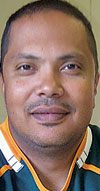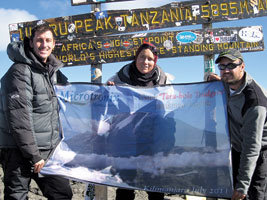
South Africa
The Sustainable Energy Society of Southern Africa (SESSA) has established a new heat pump division. The new division, headed by Neil Ross, will aim to promote the use of heat pump technology across all segments of the sustainable energy market through education and communication, and by engaging with all stakeholders in the industry. Membership of the division is open to any entity selling, installing or maintaining heat pump technologies, as well as those involved in providing services, such as finance, to the heat pump industry.

Pan African Capital recently purchased a 25,1% share in XLink Communications, a company specialising in wireless-based EFT communication solutions and a player in the fast growing sector of machine-to-machine (M2M) communication solutions. XLink’s improved BEE accreditation status, now a level four contributor, will facilitate active targeting of government and parastatal opportunities.
Three members of the Microtronix management, pictured below, took some time out recently to summit Mount Kilimanjaro.

Overseas
Business
EXFO reported record sales and bookings for its fiscal year ended 31 August 2011. Annual sales increased 33,0% to $269,7 million while GAAP net earnings totalled $19,3 million, or $0,31 per diluted share, compared to last year’s $6,6 million, or $0,11 per diluted share.
Net sales for Freescale Semiconductor’s third quarter of 2011 were $1,14 billion, compared to $1,22 billion in the second quarter of 2011 and $1,15 billion in the third quarter of 2010. Net loss for the third quarter of 2011 was $88 million, or $0,36 per share, compared to a loss of $168 million, or $0,79 per share, in the second quarter of 2011 and a loss of $156 million, or $0,79 per share, in the same period last year. The company’s net sales suffered across nearly all product categories, including microcontrollers, RF, analog and sensors, networking and multimedia, and cellular.
Companies
Nordic Semiconductor recently shipped its 500 millionth 2,4 GHz ULP wireless chip. The fabless Norwegian semiconductor company specialises in ULP (ultra low-power) short-range wireless communication in the licence-free 2,4 GHz and sub 1 GHz industrial, scientific and medical (ISM) bands.
Zestron, a supplier of cleaning media relevant to the electronics manufacturing industry, recently updated its ISO 9001 certification to ISO 9001:2008 in order to assure customers of its quality standards in all departments, including research and development, production and sales, and thus for the final cleaning media.
QNX Software Systems has announced that Tridium, a global leader in automation technology and device-to-enterprise integration, has optimised the latest version of its Niagara Framework, NiagaraAX 3.6, to run on the QNX Neutrino real-time operating system (RTOS). The Niagara Framework powers Tridium’s JACE AX controllers, which are deployed in a variety of applications, including energy and sustainability management, intelligent building automation, M2M, telecommunications, industrial, security, lighting control, convergence retailing and smart facilities management. To date, more than a quarter million instances of the Niagara Framework operate in 50 countries.
Industry
Despite recessional fears, the automotive semiconductor market is growing almost twice as fast as the overall semiconductor market. Research firm Databeans forecasts that semiconductors in automotive applications will experience a 9% compound annual growth rate over the next five years, taking the current $25 billion market to about $40 billion in 2016. The regional update for automotive electronics has Europe finishing the year with 32% of the revenue, followed by Japan and the Asia-Pacific region. Like many other application markets, Asia-Pacific exhibits the highest growth numbers with a 14% average annual growth rate.
Revenues for high-brightness LEDs grew by a remarkable 108% to $11,2 billion in 2010, according to a new market report by Strategies Unlimited. The growth was propelled by applications in TV backlight units, but expanding supply and a slowdown in overall TV demand in 2011 led to a drastic drop in LED prices, leading to a revised estimate of $12,3 billion in LED revenues for 2011. Revenue is expected to peak in 2014 at $16,2 billion and then fall to $15,3 billion in 2015. The dip in revenues will be temporary, as lighting will take over as the engine for growth after 2015.
China recently completed its largest highway lighting upgrade with more than 10 000 street lights featuring more than a million Cree XLamp XP-G and XP-E white LEDs. The Shenzhen highway project includes nearly 120 km of roadways, with LED fixtures installed along one tunnel and four highways. According to the Energy Management Contract (EMC) business model implemented by Kingsun, the company which made the luminaires, the energy savings associated with the Shenzhen project can be put toward the installation’s upfront costs for an estimated return on investment of only four years.

Throughout 2010, USB continued its run as the most successful interface ever, with over 3,5 billion devices shipping worldwide in the PC, PC peripheral, consumer electronic (CE), communications and automotive product segments. Today there are three different specifications to handle additional speed and data requirements, and although not all have met with the same amount of success, each plays a significant role in connecting a myriad of electronic devices. New In-Stat research forecasts that USB-enabled device shipments will approach 6 billion in 2015. This growth will be propelled by the transition to SuperSpeed USB or USB 3.0, which is occurring more quickly than anticipated.
Technology
Imec and Holst Centre have developed a fully integrated, ultra low-power IR-UWB (impulse radio ultra wideband) solution for use in the worldwide available 6–10 GHz band. The radio delivers high-quality communication for battery-operated mobile and sensing applications. Application examples include short-range video streaming or around-the-body audio streaming (eg, between a headset and a smartphone). According to the developers, when using the UWB radio for the wireless streaming of audio between for example a smartphone and an earpiece, the battery lifetime of the smartphone will increase by over 3x compared to a conventional Bluetooth-based solution, and the earpiece will have a battery lifetime increase of over 5x.


© Technews Publishing (Pty) Ltd | All Rights Reserved